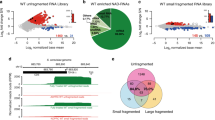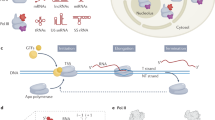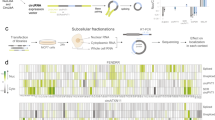Abstract
IN recent years, a precursor–product relationship between heterogeneous nuclear RNA (HnRNA) and cytoplasmic messenger RNA (mRNA) has been investigated intensively1,2. The HnRNA was shown to have a double-stranded hairpin structure within its long molecules3–5. This particular region has been isolated as a double-stranded RNA (dsRNA) after treatment with ribonucleases, followed by purification on cellulose5 or hydroxyapatite3,4. The HnRNA of higher organisms is degraded largely in the nucleus and, at most, 10% of the nuclear content is transported to the cytoplasm2. It remains unknown whether the double-stranded structures in the HnRNA molecules are totally degraded in the nucleus or whether sequences involved in this structure are preserved in part or in toto during nuclear processing and possibly become parts of cytoplasmic mRNA.
This is a preview of subscription content, access via your institution
Access options
Subscribe to this journal
Receive 51 print issues and online access
$199.00 per year
only $3.90 per issue
Buy this article
- Purchase on Springer Link
- Instant access to full article PDF
Prices may be subject to local taxes which are calculated during checkout
Similar content being viewed by others
References
Brawerman, G., A. Rev. Biochem., 43, 621–642 (1974).
Lewin, B., Cell, 4, 11–20 (1975).
Jelinek, W., and Darnell, J. E., Proc. natn. Acad. Sci. U.S.A., 69, 2537–2541 (1972).
Ryskoy, A. P., Saunders, G. F., Farashyan, V. R., and Georgiev, G. P., Biochim. biophys. Acta, 312, 152–164 (1973).
Monckton, R. P., and Naora, H., Biochim. biophys. Acta, 335, 139–154 (1974).
Naora, H., Whitelam, J. M., Monckton, R. P., and Wettenhall, R. E. H., in The Eukaryote Chromosome (edit. by Peacock, W. J., and Brock, R. D.), (Australian National University Press, 1975).
Schreier, M. H., and Staehelin, T., J. molec. Biol., 73, 329–349 (1973).
Perry, R. P., La Torre, J., Kelley, D. E., and Greenberg, J. R., Biochim. biophys. Acta, 262, 220–226 (1972).
Schonberg, M., Silverstein, S. C., Levin, D. H., and Acs, G., Proc natn. Acad. Sci. U.S.A., 68, 505–509 (1971).
Shimotohno, K., and Miura, K., Virology, 53, 283–286 (1973).
Davidson, E. D., and Britten, R. J., Q. Rev. Biol., 40, 565–613 (1973).
Davis, R. W., Simon, M., and Davidson, N., in Methods in Enzymology, XXI (edit. by Grossman, L., and Moldave, L. K.), 413–428 (Academic New York and London, 1971).
Darnell, J. E., Jelinek, W. R., and Molloy, G. R., Science, 181, 1215–1221 (1973).
White, H. B., III, Laux, B. E., and Dennis, D., Science, 175, 1264–1266 (1972).
Riley, W. T., J. theor. Biol., 40, 285–300 (1973).
Williamson, R., Morrison, M., Lanyon, G., Eason, R., and Paul, J., Biochemistry, 16, 3014–3021 (1971).
Busch, H., in The Molecular Biology of Cancer (edit. by Busch, H.), 187–239 (Academic, New York, 1974).
McKnight, G. S., and Schimke, R. T., Proc. natn. Acad. Sci. U.S.A., 71, 4327–4331 (1974).
Bernardi, A., and Bernardi, G., in The Enzymes, IV 3rd ed. (edit. by Boyer, P. D.), 329–336 (Academic, New York and London, 1971).
Grunberg-Manago, M., Prog. Nucl. Acid Res., 1, 93–133 (1963).
Stulberg, M. P., and Isham, K. R., in Methods in Enzymology, XXIV (edit. by Grossman, L., and Moldave, L. K.), 477–482 (Academic, New York and London, 1974).
Hilmoe, R. J., J. biol. Chem., 235, 2117–2121 (1960).
Whitecome, P., Fry, K., and Jalser, W., in Methods in Enzymology, XXIX (edit. by Grossman, L. and Moldave, L. K.), 295–321 (Academic, New York and London, 1974).
Soreq, H., Nudel, U., Salomon, R., Revel, M., and Littauer, U. Z., J. molec. Biol., 88, 233–245 (1974).
Molloy, G. R., Jelinek, W., Salditt, M., and Darnell, J. E., Cell, 1, 43–53 (1974).
Dina, D., Meza, I., and Crippa, M., Nature, 248, 486–490 (1974).
Firtel, R. A., and Lodish, H. F., J. molec. Biol., 79, 295–314 (1973).
Perry, R. P., Kelley, D. E., and La Torre, J., J. molec. Biol., 82, 315–332 (1974).
Derman, E., and Darnell, J. E., Cell, 3, 255–264 (1974).
Author information
Authors and Affiliations
Rights and permissions
About this article
Cite this article
NAORA, H., WHITELAM, J. Presence of sequences hybridisable to dsRNA in cytoplasmic mRNA molecules. Nature 256, 756–759 (1975). https://doi.org/10.1038/256756a0
Received:
Accepted:
Issue Date:
DOI: https://doi.org/10.1038/256756a0
This article is cited by
-
Nucleotide sequence complementarity between adenovirus 2-coded VA RNA and host cell pre-mRNa
Molecular Biology Reports (1981)
Comments
By submitting a comment you agree to abide by our Terms and Community Guidelines. If you find something abusive or that does not comply with our terms or guidelines please flag it as inappropriate.



